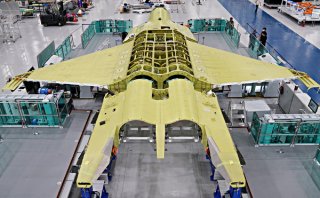KF-X Project (South Korea's Stealth Fighter) Has a Problem
South Korea sold a large investment share--approximately 20% of the initial costs, or just under $1.5 billion--to Indonesia in an effort to offset the project’s steep initial costs, but Jakarta has fallen approximately $420 million behind in payments as of August.
South Korea is forging ahead with the development of its first indigenously-produced fighter, but the project faces financial perils from stalled negotiations with a major foreign investor.
A video and series of photos, released earlier this week by South Korean defense conglomerate Korea Aerospace Industries (KAI), shows the first KF-X fighter prototype in its final stages of assembly. The video shows what appears to be largely complete fuselage and wings that are in the process of being joined in three major points.
The KF-X is a single-seat, twin-engine 4.5 generation fighter that iterates on the F-16 concept with improved aerodynamic performance, expanded hardpoints, several new stealth features, and a domestically produced AESA radar.
The initial batch of KF-X units will ship with an external armament loadout, but later revisions will additionally boast an internal weapons bay for the long-range air-to-surface missiles being developed by South Korean manufacturer LIG Nex1. The first serial unit is slated for completion by April 2021. Mass production is scheduled to begin in 2028, with as many as 120 models in service by 2032.
If all goes according to Seoul’s ambitious timetable, the KF-X will phase out the Republic of Korea Air Force’s (ROKAF) aging stock of Northrop F-5E and F-4 Phantom II fighters, as well as certain F-16 models, over the coming decades.
Researching, developing, and producing the initial batch of KF-X units has cost South Korea around $7 billion since the project’s inception in the 2000’s. Another $16 billion will reportedly be required to produce the upcoming KF-X units, putting the cost per model at around $130 million.
The KF-X project is a salient financial and logistical burden on South Korea’s fledgling defense sector, especially given that Seoul has opted to domestically produce expensive components like AESA radars that could otherwise be imported at a more competitive price.
South Korea sold a large investment share--approximately 20% of the initial costs, or just under $1.5 billion--to Indonesia in an effort to offset the project’s steep initial costs, but Jakarta has fallen approximately $420 million behind in payments as of August. Indonesia now seeks to renegotiate the terms of the contract, which stipulated a 20% investment share in exchange for one prototype model and Korean technical expertise, though talks appear to have sputtered to a halt.
Precise details from the negotiations remain elusive, but Indonesia’s position centers around two major grievances: ongoing disagreements over export licensing terms, and the allegation that Indonesian engineers are being denied technical access to key parts of the project. The former seems far more serious, pointing to a deep-seated divergence between Indonesia and South Korea over basic ownership rights. It is unclear if these differences can be meaningfully broached; as a South Korean defense source told The Korea Times, “Little progress has been made in terms of cooperation with Indonesia regarding the KF-X project.”
It remains to be seen if this unexpected investment deficit will prompt Seoul to revise its production target of 120 units over the coming decade. South Korea may very well be willing to absorb these losses, considering that the KF-X program was never meant to secure an immediate return on investment-- if saving money was a top priority, South Korea could simply have imported a similarly-equipped fighter for much less. Rather, Seoul’s underlying goal with its first homegrown fighter is to lay the long-term groundwork for a profitable fighter export business. Indonesia’s potential withdrawal as an investment partner would hinder, but not inherently invalidate, South Korea’s ongoing bid to become a major military exporter in the Asia-Pacific region.
Mark Episkopos is a frequent contributor to The National Interest and serves as a research assistant at the Center for the National Interest. Mark is also a PhD student in History at American University.


